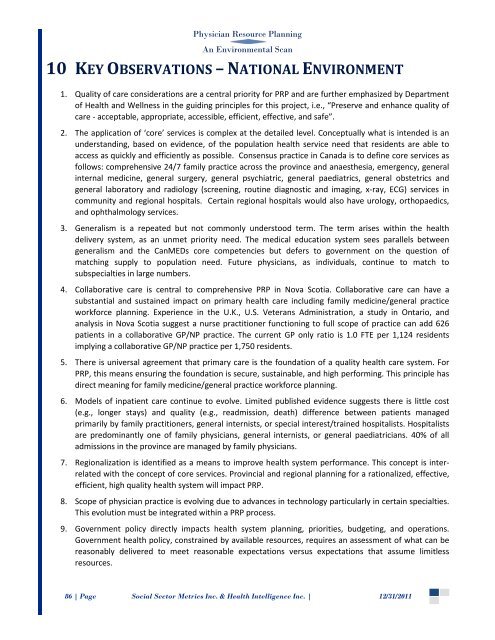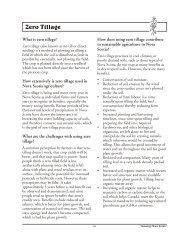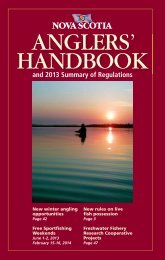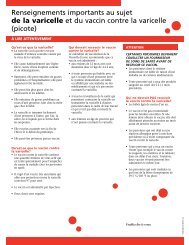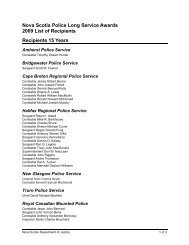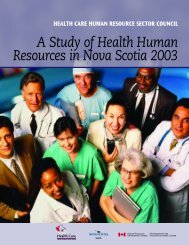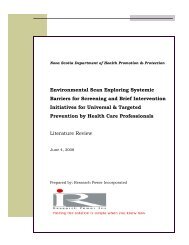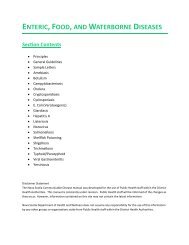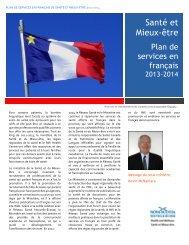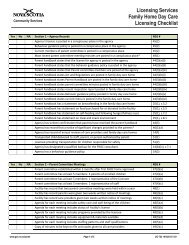Environmental Scan - Government of Nova Scotia
Environmental Scan - Government of Nova Scotia
Environmental Scan - Government of Nova Scotia
You also want an ePaper? Increase the reach of your titles
YUMPU automatically turns print PDFs into web optimized ePapers that Google loves.
Physician Resource PlanningAn <strong>Environmental</strong> <strong>Scan</strong>10 KEY OBSERVATIONS – NATIONAL ENVIRONMENT1. Quality <strong>of</strong> care considerations are a central priority for PRP and are further emphasized by Department<strong>of</strong> Health and Wellness in the guiding principles for this project, i.e., “Preserve and enhance quality <strong>of</strong>care - acceptable, appropriate, accessible, efficient, effective, and safe”.2. The application <strong>of</strong> ‘core’ services is complex at the detailed level. Conceptually what is intended is anunderstanding, based on evidence, <strong>of</strong> the population health service need that residents are able toaccess as quickly and efficiently as possible. Consensus practice in Canada is to define core services asfollows: comprehensive 24/7 family practice across the province and anaesthesia, emergency, generalinternal medicine, general surgery, general psychiatric, general paediatrics, general obstetrics andgeneral laboratory and radiology (screening, routine diagnostic and imaging, x-ray, ECG) services incommunity and regional hospitals. Certain regional hospitals would also have urology, orthopaedics,and ophthalmology services.3. Generalism is a repeated but not commonly understood term. The term arises within the healthdelivery system, as an unmet priority need. The medical education system sees parallels betweengeneralism and the CanMEDs core competencies but defers to government on the question <strong>of</strong>matching supply to population need. Future physicians, as individuals, continue to match tosubspecialties in large numbers.4. Collaborative care is central to comprehensive PRP in <strong>Nova</strong> <strong>Scotia</strong>. Collaborative care can have asubstantial and sustained impact on primary health care including family medicine/general practiceworkforce planning. Experience in the U.K., U.S. Veterans Administration, a study in Ontario, andanalysis in <strong>Nova</strong> <strong>Scotia</strong> suggest a nurse practitioner functioning to full scope <strong>of</strong> practice can add 626patients in a collaborative GP/NP practice. The current GP only ratio is 1.0 FTE per 1,124 residentsimplying a collaborative GP/NP practice per 1,750 residents.5. There is universal agreement that primary care is the foundation <strong>of</strong> a quality health care system. ForPRP, this means ensuring the foundation is secure, sustainable, and high performing. This principle hasdirect meaning for family medicine/general practice workforce planning.6. Models <strong>of</strong> inpatient care continue to evolve. Limited published evidence suggests there is little cost(e.g., longer stays) and quality (e.g., readmission, death) difference between patients managedprimarily by family practitioners, general internists, or special interest/trained hospitalists. Hospitalistsare predominantly one <strong>of</strong> family physicians, general internists, or general paediatricians. 40% <strong>of</strong> alladmissions in the province are managed by family physicians.7. Regionalization is identified as a means to improve health system performance. This concept is interrelatedwith the concept <strong>of</strong> core services. Provincial and regional planning for a rationalized, effective,efficient, high quality health system will impact PRP.8. Scope <strong>of</strong> physician practice is evolving due to advances in technology particularly in certain specialties.This evolution must be integrated within a PRP process.9. <strong>Government</strong> policy directly impacts health system planning, priorities, budgeting, and operations.<strong>Government</strong> health policy, constrained by available resources, requires an assessment <strong>of</strong> what can bereasonably delivered to meet reasonable expectations versus expectations that assume limitlessresources.86 | Page Social Sector Metrics Inc. & Health Intelligence Inc. | 12/31/2011


